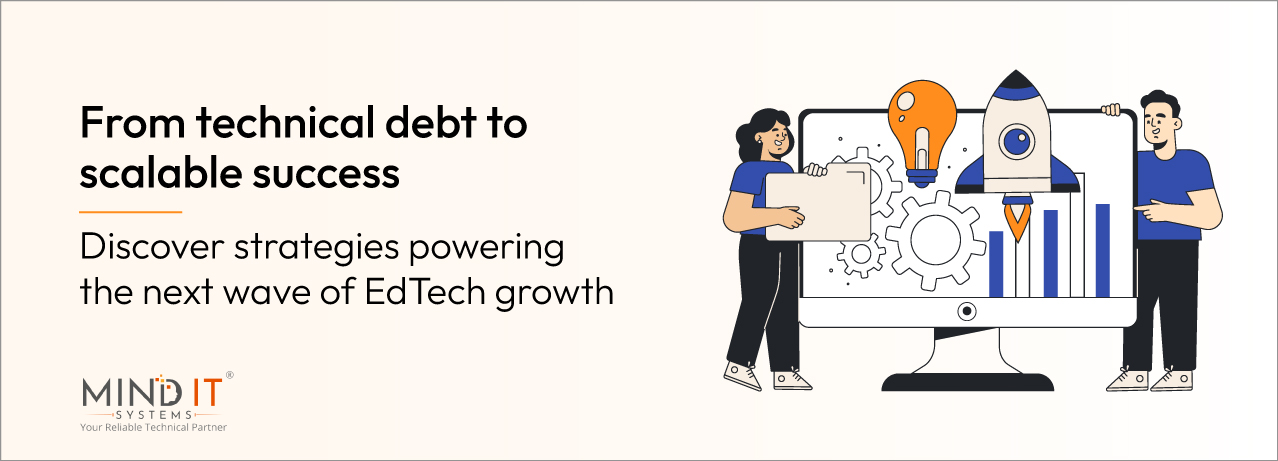
Scaling Digital Platforms: Technical Debt Resolution for Scaling EdTech Startups
Met with one of my engineering classmates, founder of an EdTech startup. She was incredible, she was passionate, and you could hear the weariness in her voice. Her platform, a genuinely innovative piece of software for K-12, had just surpassed 100,000 users. The investors were over the moon. The press was knocking on the door. And her platform was burning—and not in a good fire. It was crashing. All. The. Time.
“We rushed,” she said to me, and I could envision her rubbing her temples on her work desk. “We broke things. We got out the MVP, we built features, we worked hard. And now, now we’re paying for it. Each new feature breaks two previous ones. My best engineers are spending all their time just keeping the lights on. We can’t scale, and I feel like we’re working on quicksand.”
I just nodded and listened. I’ve been doing product engineering for what feels like an eternity, and I’ve heard this tale more times than I can remember. It’s the startup paradox: the things that propel you into orbit—speed, agility, and a constant, feature-at-all-costs attitude—are the same that can lead to a disastrous re-entry.
And in the EdTech sphere, the stakes are significantly higher. This is not another picture-sharing app. This is learning’s future. The international EdTech market is poised to become a $400 billion market by 2025 [1]. However, for every unicorn, there are dozens of startups that fail to take off. Not because their vision was terrible, but because their tech couldn’t support their own popularity.
Mind IT® contributed significantly to Swayam, India’s largest MOOC, with over thirty million users now. We had to reengineer an existing old product completely, with complete buy-in from Microsoft, with whom we worked. Tech experts know that scalability, the culprit nearly every time, is often driven by technical debt.
The Kind of ‘Growth’ That Kills You
Technical debt is the silent assassin of EdTech startups. It’s the ghost in the machine, the cumulative total of all the “we’ll get to that eventually” choices you made to meet a launch deadline. It’s the ugly code, the omitted tests, the monolithic architecture that worked great for your initial 1,000 users but is a complete disaster for 100,00,00.
As the software guru Martin Fowler has pointed out for years, this kind of debt is often the #1 bottleneck to scaling [2]. It’s not a sign of a bad team; it’s a sign of a team that did what it had to do to survive. But once you’ve survived, that debt starts to collect interest. And the interest payments are a killer:
- Innovation Comes to a Standstill: Your feature speed, the very factor that made you different, comes to a grinding halt. Minor alterations that used to take a day now take weeks.
- Your Top Talent Abandons Ship: Your best engineers grow tired of it. They are builders, not firemen. They didn’t go in for this to spend their days fixing a leaky, groaning system. They want to build, not just manage.
- Onboarding is a Nightmare: You can’t even add more bodies to the problem. It becomes a nightmare to onboard new devs because the codebase is now a convoluted mess that only the original devs comprehend (and even they’re beginning to get lost).
- The User Experience Dies: The app becomes buggy. It’s slow. It crashes during heavy use (like, you know, just before final exams). And in a world with a million alternatives, angry students and teachers don’t hang around. They just…leave.
Your MVP, that very product that funded you and got you to this point of success, turns into an anchor. And as you’re stuck trying to stitch it somehow, your competitors sail on by you.
The Way Out: From Firefighting to Future-Proofing
So, how do you dig yourself out of this hole? You don’t do it by adding more features. You do it by making a conscious, strategic decision to pay down your debt and re-engineer for scale.
I experienced this firsthand with Edtech platform, Swayam, which now has scaled to more than 30 million users. It started life as a typical, monolithic all-in-one. But as it scaled, we realized that wasn’t going to cut it. We needed to begin thinking like a platform, not a product.
Here’s what that actually looked like:
- Break It Up (Microservices): We embarked on a process of surgically excising sections of the monolith into tiny, stand-alone services. Rather than a single massive, knotted application, we had distinct services for user authentication, course materials, assignments, and discussion forums. If the forum service was buggy, it didn’t bring down the whole platform. It was isolated.
- Establish on Rock, Not Sand (Database & Backend): We ensured the base was solid. We employed a strong databases, multiple type, and scalable backend framework that could manage intricate data relationships and scale with us. We scaled from the onset, utilizing things such as read replicas to balance the database load as traffic detonated.
- Automate Everything You Can (DevOps): We created a culture in which automation was the ruler. New code was deployed and tested automatically. This enabled us to push small, safe, incremental changes dozens of times a day rather than making those big, scary, hold-your-breath releases once a month.
This is not about a huge, multi-year overhaul. That’s a kiss of death to a startup. This is about a pragmatic, phased strategy. You take the area of your system that hurts the most and you repair that first. You develop a modernization plan that is parallel to your product plan.
The ROI of Doing It Right (Yes, There’s a Huge One)
This is where I find founders and CTOs tending to stall. “I cannot risk slowing down our feature pipeline to rewrite old code.” I understand. But my reply is always the same: “You can’t afford not to.”
The payoff on this type of internal investment is enormous, and it is not merely about having a more elegant codebase. It’s about real, quantifiable business effect.
- Real Cost Savings: A study discovered that schools implementing well-designed EdTech solutions realized 20-40% administrative cost savings [3]. That’s real money you can invest in growth.
- Real Learning Gains: Students learning with adaptive learning technology (which is not possible on an unstable backend) require 40-60% less time to meet their learning goals [3]. That’s not a feature; that’s a game-changing outcome.
- A Team That Remains: If you eliminate all the friction and firefighting, your developers can actually do what they are best at: creating great things. Their productivity rockets, and more importantly, they remain.
The Smartest Shortcut I Know: Staff Augmentation
Finally, the million-dollar question: “This all sounds wonderful, but my team is already drowning. I don’t have the personnel to do this.”
This is the most frequent and most legitimate fear I hear. And the solution isn’t to attempt to hire an entire new batch of pricey, hard-to-find platform engineers. The solution is to be strategic. The solution is staff augmentation.
But I’m not referring to merely outsourcing your issues. I’m referring to surgically implanting expertise into your organisation. You hire a small team of experienced senior engineers who have been down this road before and know the ending. They’ve scaled platforms. They’ve refuted technical debt. They don’t only code, but they also mentor your current team, implement best practices, and assist you in developing the skills for internal scaling.
Imagine it like calling in a Special Forces team to train your troops. They arrive, assist you in completing a key mission, and depart, leaving your soldiers tougher and more capable than they were when they arrived. It’s the absolute quickest method for closing the gap between your current team and your ideal team.
Your Platform Is Your Product
The EdTech revolution is underway, but it will be constructed on platforms that can actually deliver on their commitments. The era of “good enough” technology is in the past. Your users—the students, the teachers, the administrators—they demand a seamless, dependable, and captivating experience. They will not stand for crashes, slow loads, or buggy functionality.
That founder I was talking to? She’s on the right track now. We assisted her in coming up with a realistic plan to begin whittling down her technical debt, beginning with the largest fires. Her team is once again fired up. They’re shipping features and enhancing the platform. They’re no longer just surviving; they’re shipping for the future.
Your technology isn’t just a line item on a budget. It’s the very foundation of your product. And if that foundation is made of sand, it doesn’t matter how beautiful the house is. It’s only a matter of time before it all comes tumbling down.
References
1. HolonIQ. (2022). EdTech in 10 Charts. https://www.holoniq.com/edtech-in-10-charts
2 Fowler, M. (2022). Bottleneck #01: Tech Debt. https://martinfowler.com/articles/bottlenecks-of-scaleups/01-tech-debt.html
3 Codebridge. (2025). The ROI of Educational Technology Tools. https://www.codebridge.tech/articles/the-roi-of-educational-technology-tools-reshaping-learning-for-a-smarter-future
Share this post
About the Author

Sriram
(Project Manager )
Sriram is an e-learning expert with almost two decades of experience spanning across India’s leading e-learning companies. At Mind IT Systems, Sriram works as a Project Management Specialist and helps in building organizational culture. His hobbies include traveling, stamps, and coins collection and he can talk for hours about stock market investments.

